Mexicans hold generally positive views of the United States, while Americans hold generally negative views of Mexico – a reversal from 2017 – according to Pew Research Center surveys conducted in both countries earlier this year.
In this analysis, we’ll take a closer look at how Mexicans and Americans view the other country, as well as their attitudes about how each government is handling the large number of migrants seeking to cross the border from Mexico in the U.S.
This Pew Research Center analysis focuses on how Mexicans and Americans view each other and how they rate their governments’ handling of the situation at the U.S.-Mexico border. The analysis also explores Mexicans’ opinions of U.S. presidents and other world leaders.
For Mexico data, this analysis draws on a nationally representative survey of 1,042 adults conducted from Feb. 23 to April 27, 2024. The survey was conducted face-to-face.
In the United States, we surveyed 3,600 adults from April 1 to April 7, 2024. Everyone who took part in this survey is a member of the Center’s American Trends Panel (ATP), an online survey panel that is recruited through national, random sampling of residential addresses. This way nearly all U.S. adults have a chance of selection. The survey is weighted to be representative of the U.S. adult population by gender, race, ethnicity, partisan affiliation, education and other categories. Read more about the ATP’s methodology.
To compare educational groups across countries, we standardize education levels based on the UN’s International Standard Classification of Education (ISCED).
Prior to 2024, combined totals were based on rounded topline figures. For all analyses beginning in 2024, totals are based on unrounded topline figures, so combined totals might be different than in previous years. Refer to the 2024 topline to see our new rounding procedures applied to past years’ data.
Here are the questions used for this analysis, along with responses, and the survey methodology.
How Mexicans view the U.S., and how Americans view Mexico
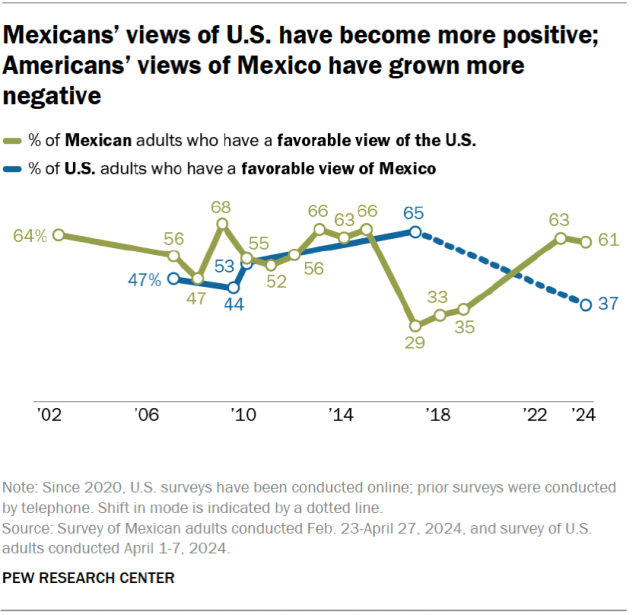
Mexicans and Americans view the other country in opposite ways:
- Most Mexicans (61%) have a favorable view of the U.S., compared with 33% who hold an unfavorable view.
- By contrast, 60% of Americans have an unfavorable view of Mexico, while 37% have a favorable view of their southern neighbor.
These attitudes have changed markedly over time. As recently as 2017 – when Donald Trump was the president of the U.S. – only 29% of Mexicans had a favorable opinion of their northern neighbor. And 65% of Americans had a favorable opinion of Mexico.
Related: Globally, Biden Receives Higher Ratings Than Trump

(It’s important to note that our U.S. surveys are now conducted online. Prior to 2020, we conducted U.S. surveys by phone, which means that findings before and after the change in survey mode may not be directly comparable.)
Differences by age, race and ethnicity, and party
In Mexico and the U.S. alike, views of the other country differ by age and other factors. For example, 71% of Mexican adults under 30 have a positive view of the U.S., compared with only half of Mexicans ages 65 and older.

Similarly, younger Americans are more positive toward Mexico than older Americans are. Around half of U.S. adults under 30 (48%) have a favorable view of Mexico, compared with just 25% of those ages 65 and older.
Americans’ attitudes toward Mexico also differ by race and ethnicity. Around half of Hispanic Americans (53%) see Mexico positively, compared with only 30% of White, non-Hispanic Americans. Other racial and ethnic groups are more evenly divided in their sentiments.
There are also large partisan differences in the U.S.: 52% of Democrats and Democratic-leaning independents have a favorable view of Mexico, compared with only 22% of Republicans and Republican leaners.
When we first asked this question in 2007, Democrats and Republicans were about equally favorable toward the country (49% and 45%, respectively). Notably, views of Mexico have become more negative among Americans in both parties since 2017.
Views of the U.S. government’s handling of the border
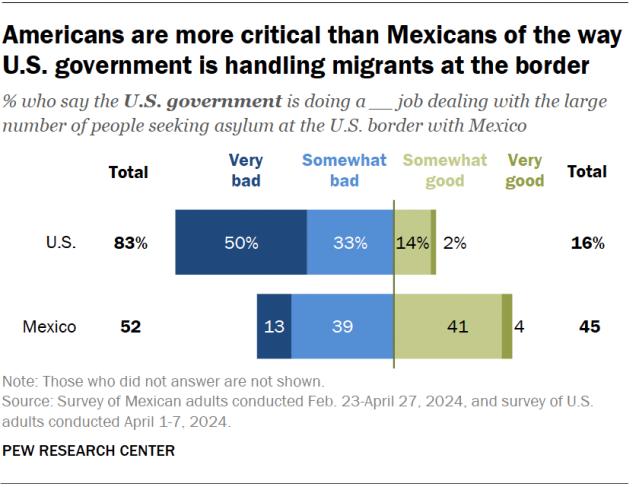
Americans are much more critical than Mexicans of the way the U.S. government is dealing with the large number of migrants seeking asylum at the U.S. border with Mexico. (The survey was conducted before a recent decline in migrant encounters at the border due to asylum policy changes in the U.S. and Mexico.)
More than eight-in-ten Americans (83%) say the U.S. government is doing a bad job dealing with migrants at the border, including half who say the government is doing a very bad job. By comparison, a much smaller share of Mexicans (52%) say the U.S. government is doing a bad job, including just 13% who say it’s doing a very bad job.
Differences by education, income and party
In both countries, higher levels of education and income are associated with more negative views of the U.S. government’s handling of the border situation. For example, Mexicans with higher levels of education are 13 percentage points more likely than Mexicans with less education to rate the U.S. government’s handling of the situation poorly.
When it comes to party, however, Republicans are more likely than Democrats to say the U.S. government is doing a bad job managing the border (92% vs. 76%). In Mexico, those who support the governing political parties and those who do not have similar views on this question.
Related: Latinos’ Views on the Migrant Situation at the U.S.-Mexico Border
Views of the Mexican government’s handling of the border
We also asked people in both countries to rate the Mexican government’s handling of the large number of people seeking asylum at the border.
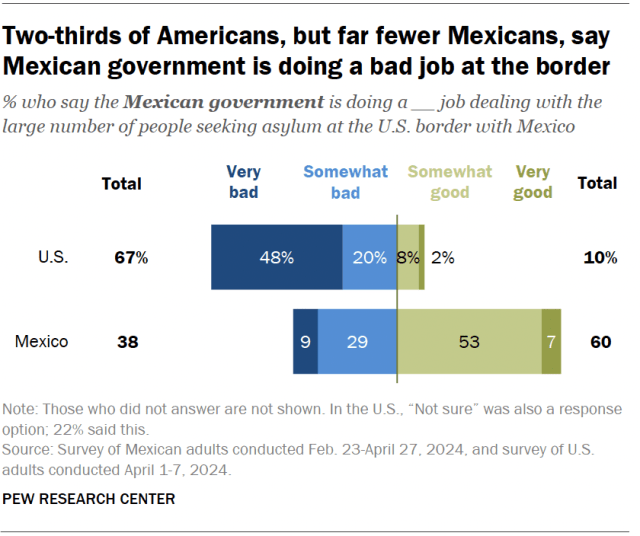
Again, Americans express much more negative views than Mexicans. Two-thirds of U.S. adults say the Mexican government is doing a bad job, including 48% who say it is doing a very bad job. A much smaller share of Mexicans (38%) say their government is doing a bad job, and only 9% say it is doing a very bad job.
Differences by education, income, age and party
In both countries, those with higher levels of education tend to have more negative views of the Mexican government’s handling of the border situation. For instance, Mexicans with more education are 17 percentage points more likely than Mexicans with less education to rate the government’s border response poorly.
When it comes to income, views differ in the U.S., but not in Mexico. Americans with higher incomes are more likely than those with lower incomes to say Mexico is doing a bad job handling the border.
Americans ages 65 and older are much more likely than U.S. adults under 30 to say the Mexican government is doing a bad job at the border (80% vs. 50%).
While U.S. partisans generally rate the Mexican government poorly when it comes to the border, Republicans are much more likely than Democrats to hold a negative view (80% vs. 58%). And in Mexico, those who do not support the governing parties are more likely than those who do support them to say their government is doing a bad job (48% vs. 29%).
How Mexicans view Biden and Trump
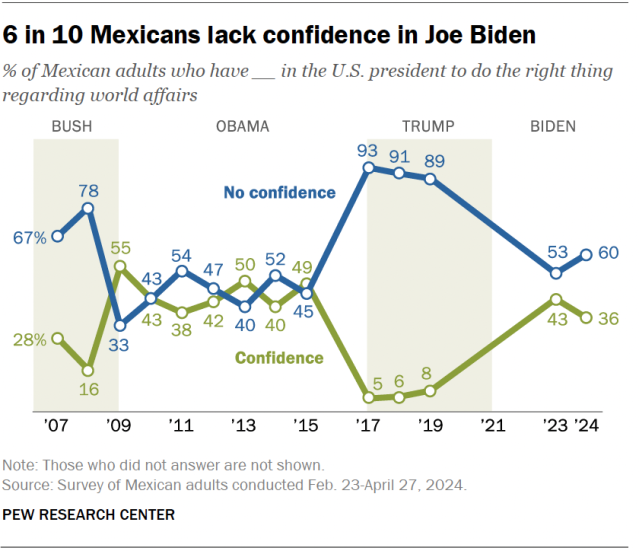
Mexicans’ confidence in the U.S. president has shifted dramatically depending on who is in office.
Trump was very unpopular with the Mexican public in 2017, as was his call for the building of a wall on the Mexico-U.S. border. More than nine-in-ten Mexicans opposed the construction of a border wall, and 93% had no confidence in Trump’s ability to lead in 2017.
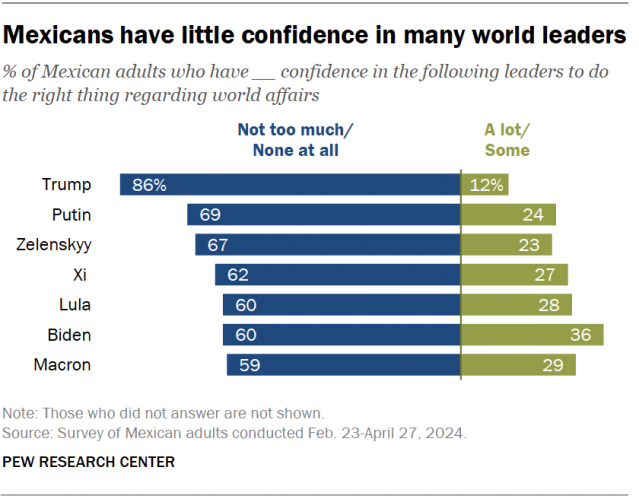
Mexicans’ views rebounded somewhat when Joe Biden took office in 2021. But today, six-in-ten Mexicans have little or no confidence in Biden. This remains below the 86% of Mexicans who today lack confidence in Trump. (This survey was conducted when Biden was still actively seeking reelection.)
More broadly, Mexicans have little to no confidence in all the world leaders we asked about in our survey, including French President Emmanuel Macron, Brazilian President Luiz Inácio Lula da Silva, Chinese President Xi Jinping and others.
Note: Here are the questions used for this analysis, along with responses, and the survey methodology.


